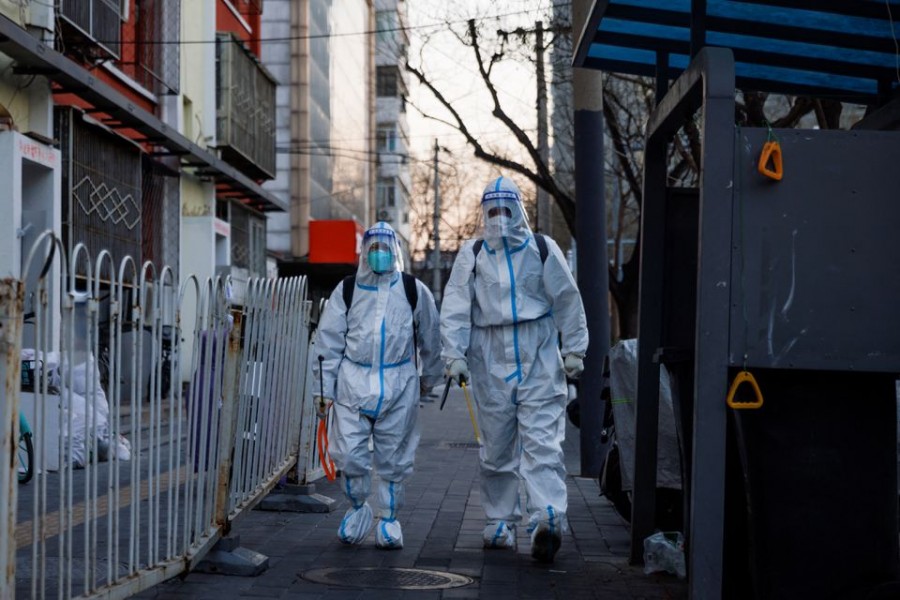A partial easing of the world's toughest COVID-19 curbs sowed confusion across China on Monday, even as global investors cheered the prospects of a broader policy shift in the wake of last month's historic protests and mounting economic damage.
Three years into the pandemic, China's zero-tolerance measures, from shuttered borders to frequent lockdowns, contrast sharply with the rest of the world, which has largely decided to live with the virus.
The strict approach has battered the world's second-largest economy, put mental strain on hundreds of millions and last month prompted the biggest show of public discontent in mainland China since President Xi Jinping took power in 2012.
Although the protests largely petered out amid a heavy police presence across major cities, regional authorities have cut back on lockdowns, quarantine rules and testing requirements to varying degrees.
China will also soon announce a nationwide easing of testing requirements, allowing some positive cases and close contacts to isolate at home, people familiar with the matter told Reuters last week.
That has prompted some analysts to suggest China may drop border controls and re-open the economy sooner than expected.
"The risk of an earlier but managed exit has increased," Goldman Sachs chief China economist Hui Shan said in a note on Monday, adding that the bank expected such a reopening from April. Other analysts expect such moves later in the year.
But the lack of clarity leaves some in China scared of being caught on the wrong side of fast-changing rules.
Yin, who lives in a small city near Beijing, the capital, said her in-laws had come down with a fever and she herself now had a sore throat, but they did not want to be tested for fear of being thrown into government quarantine facilities.
"All we want is to recover at home, by ourselves," she told Reuters, speaking on condition of anonymity.
The yuan currency firmed to its strongest level against the dollar since mid-September amid a broad market rally as investors hope the unwinding of pandemic curbs will brighten the outlook for global growth.
Economic data underscored the damage from the curbs, as services activity shrank to six-month lows in November.
But in another hopeful sign for business, a source at Apple supplier Foxconn told Reuters the firm expected its COVID-hit Zhengzhou plant - the world's biggest iPhone factory - to resume full production later this month or early the next.
CHANGING MESSAGE
Alongside the easing of local curbs, Vice Premier Sun Chunlan, who oversees COVID efforts, said last week the ability of the virus to cause disease was weakening.
That change in messaging aligns with the position held by many health officials around the world for more than a year.
As the virus weakens, conditions are improving for China to scale back management of COVID-19 as a serious contagious disease, state media outlet Yicai said late on Sunday, in comments that are among the first to float the idea.
In recent days, major cities across China have continued to loosening the toughest of those measures.
Authorities in the southwestern municipality of Chongqing urged local bodies not to test too much. "Do not repeat testing or increase testing," they said.
The eastern province of Zhejiang said it planned to largely end mass testing, while the metropolis of Nanjing dropped COVID tests for use of public transport.
So has Beijing, though entry to many office buildings in the capital still requires negative tests, leaving workers confused.
The scrapping of the requirement for negative tests to buy medicines for cold and fever in various cities, intended to deter people from using the drugs to disguise symptoms, has led instead to mass buying, some state media said.
Daily tallies of new COVID infections have also dropped in some regions as authorities row back on testing.
Although the heat of last week's protests appears to have died down, frustration can occasionally boil over.
In the central city of Wuhan, where the virus first emerged in late 2019, people pushed down barriers on Saturday to break out of a lockdown at a garment industrial park, video clips posted on Twitter showed.
Reuters was able to verify that the incident happened in Wuhan.
On a rain-soaked Sunday, dozens of students carrying umbrellas gathered at a city university to protest its COVID policies, demanding greater "transparency" by officials, according to videos widely shared on Twitter.


